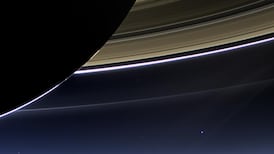The full moon this week on the 19th coincides with a deep partial lunar eclipse during the early hours of Friday morning.
From Ireland, we will catch the initial stages before moonset. The majority of North America sees the entire eclipse.
Observers in Ireland will have to contend with the moon being low as the sky brightens, but it is worth finding a clear western horizon to view the event.
The eclipse is just a fraction shy of being total, with only a small area of the lunar disk remaining outside the umbra, or central part of Earth’s shadow cast in space. This is the first partial visible from here in more than two years.
Although the eclipse commences at 6.02am, you will not see any noticeable dimming of the lunar disk until about 6.45am. A slight staining of the moon’s top edge is then apparent as it slides deeper into the penumbra, or more indistinct outer regions of our shadow.
Contact with the darker umbra occurs at 7.19am, but that time also coincides with the start of civil twilight.
However, it will be possible to track the eclipse’s progress – especially in optical instruments – up to just before sunrise, which is 7.58am from Dublin and 8.08am for Galway. The further west you are in Ireland, the more you will see of the event – the moon is halfway through the umbra by the time it sets from Galway at 8.09am.
Every lunar eclipse is different and this is no exception, with it occurring against a brightening sky before sunrise.
The upper half of the moon will appear inky to the eye as the eclipse deepens but different shades might be obvious in binoculars. Contrast that with the rest of the pale-white disk gradually taking other hues due to atmospheric absorption as the moon nears the horizon.
The curve of the Earth’s shadow will also be obvious, but it can sometimes appear slightly blunt. Careful study of its leading edge may reveal the outline of our ozone layer as a thin, bluish fringe.
To the unaided eye, the eclipsed disk will appear a little larger due to the famed moon illusion, but also slightly squashed as it nears the horizon.
The clarity of our atmosphere can also affect the appearance of a lunar eclipse, but that is more apparent when they are total. The eruption of Mount Pinatubo in the Philippines in 1991 flung dust high into the stratosphere, leading to one of the darkest lunar eclipses in years in December 1992.
The surrounding star field is spectacular as the moon lies below the Pleiades star cluster in Taurus during the eclipse, with the torso of Orion to the area's left. However, their brighter stars are all that you might record on any wide-angle photograph as the sky lightens, but an interesting foreground will enhance any images taken.
Lunar eclipses, while no longer of any scientific importance, have a special appeal for even the most casual sky watcher. If the sky is clear this Friday, then set your alarm early for one of nature’s celestial highlights.
Fred Espenak's website has more detailed information about Friday's eclipse, while TimeandDate's page will allow you prepare animations for your location.
John Flannery (@theskybyeye) is a long-time amateur astronomer with an interest in astronomical history and sky phenomena observable with the unaided eye. He is a member of the Irish Astronomical Society.











